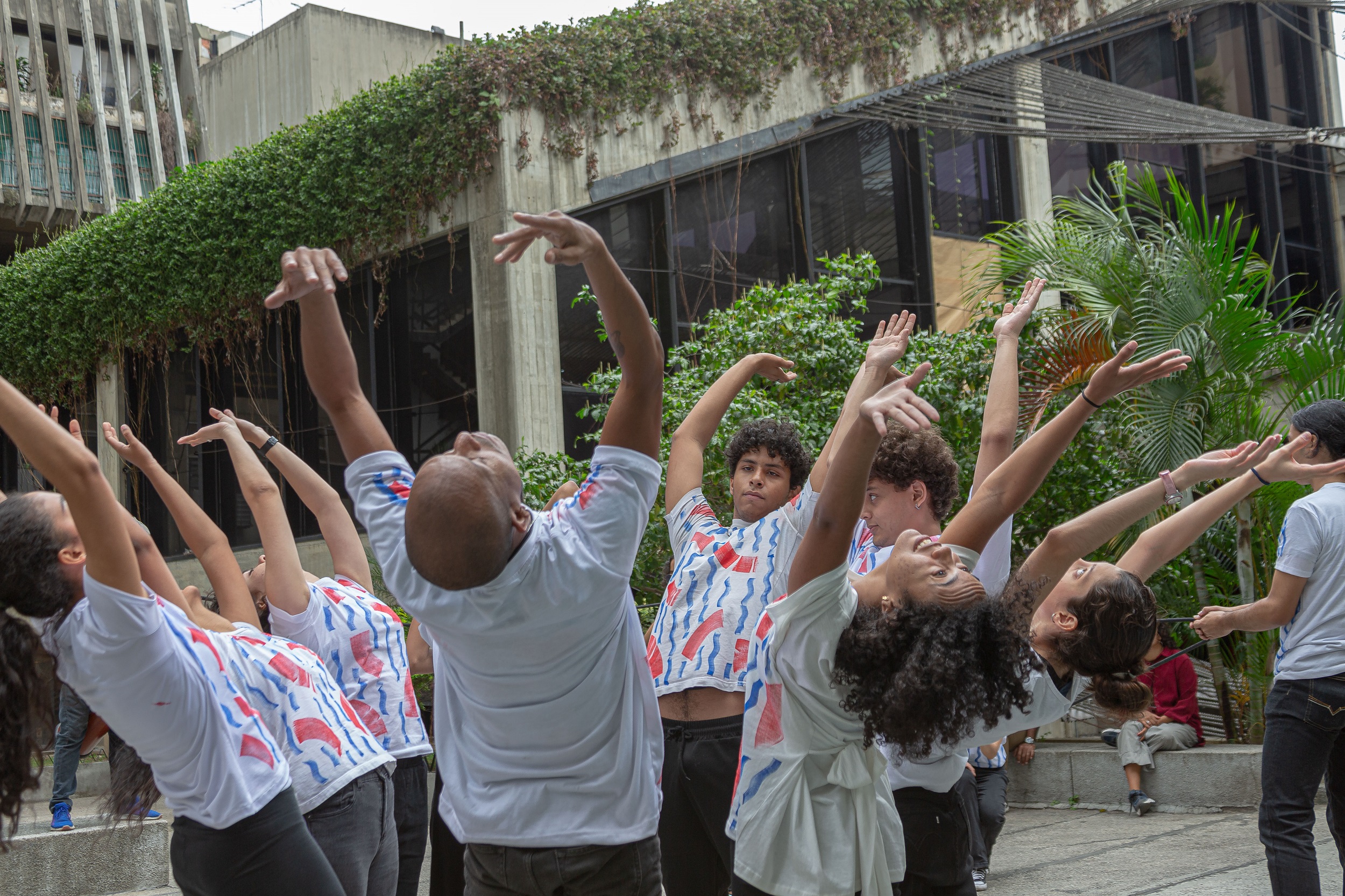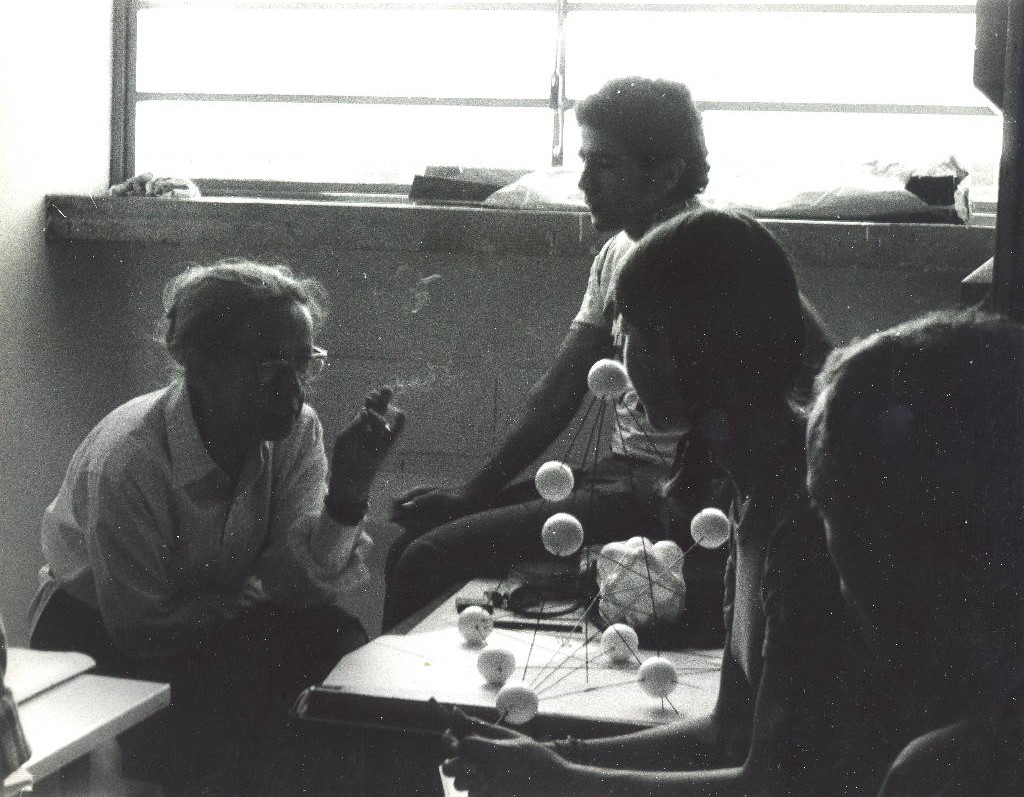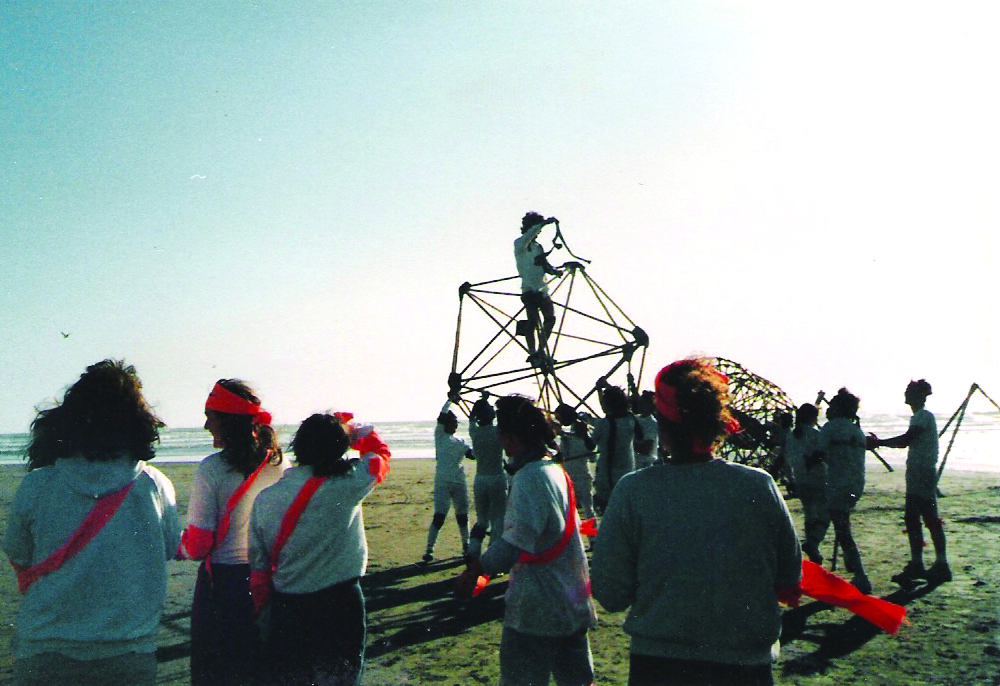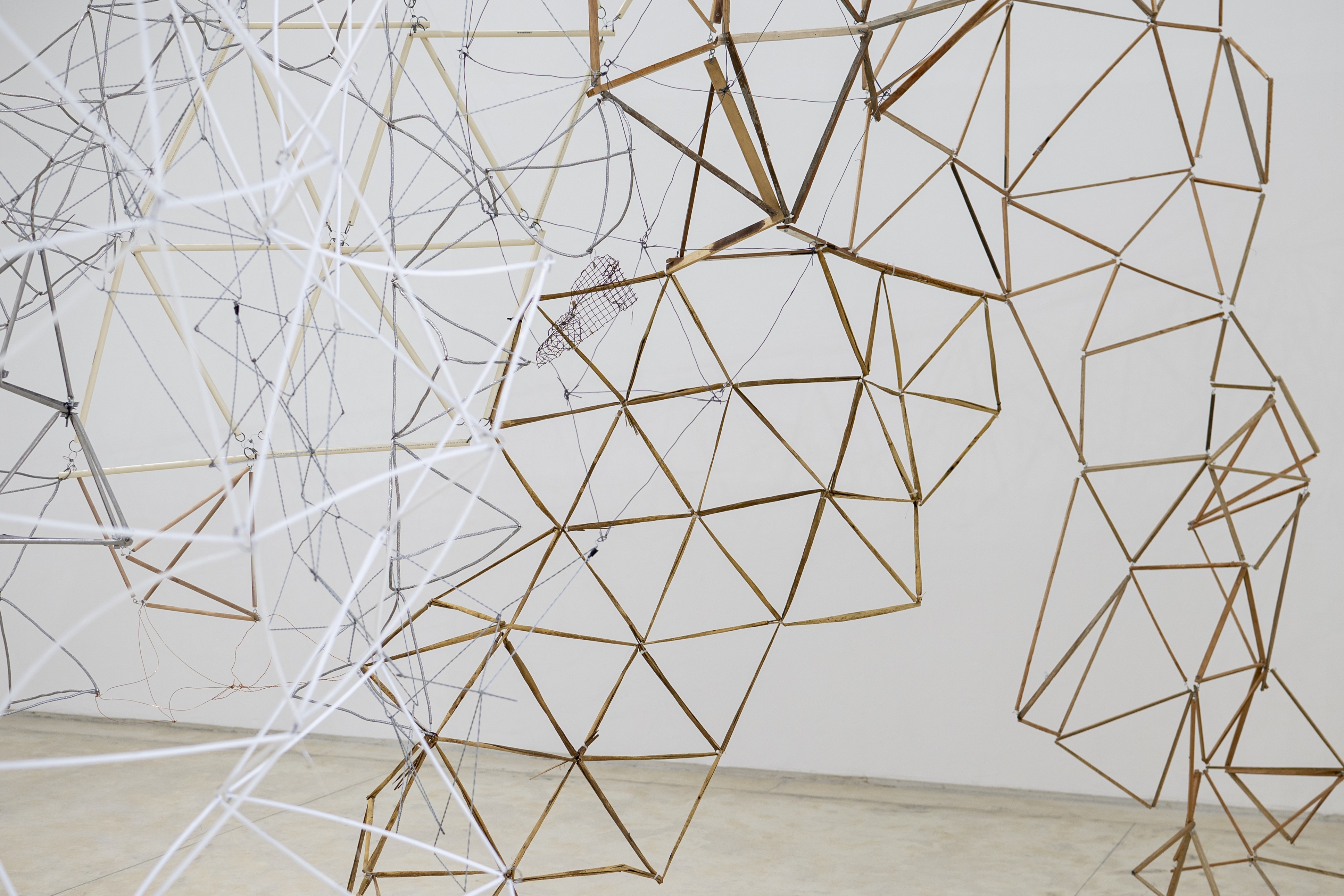Both strategies constitute a large-scale collaborative project that aims to rethink the Reticulárea, a work that has transcended time as a concept, now contextualized and reinterpreted with diverse and heterogeneous materials that speak of a present in profound transformation. Thus, the motivation to build the Reticulárea from a symbolic place, as a communal cartography of expansive forms. The reactivation of the Reticulárea is also an opportunity to create networks on the crossings between art and education throughout Latin America; generating connections as well as new meanings on what this rhizomatic structure implies, open, and expansive in nature in the midst of transits, migrations, and displacements between the different regions of Latin America. This project hopes to build another cartography of the continent, where geopolitical borders are now replaced by bridges, flows, and exchanges that draw a new network.
Collective Reticulárea: Communal Cartographies
On-site and remote participatory art project, created to reactivate the legacy of the German-Venezuelan artist Gego and her historical significance. Developed together with Fundación Gego, Sala Mendoza, and Goethe-Institut Venezuela, in collaboration with a network of Venezuelan artists, and students of the Taller X of the School of Architecture of the Central University of Venezuela. It is a project conceptualized and led by the artist Miguel Braceli, under the curatorship of Fundación Gego and Stefanie Reisinger.
Based on an international open call and an educational program, this CLASSROOM proposes to build a Collective Reticulárea, understanding it as a meeting and learning space around collaboration, weaving networks, and the bonds between art and the territory, addressing issues of migrations, diasporas, and displacements throughout Latin America. Click here to learn more about the ways to participate.
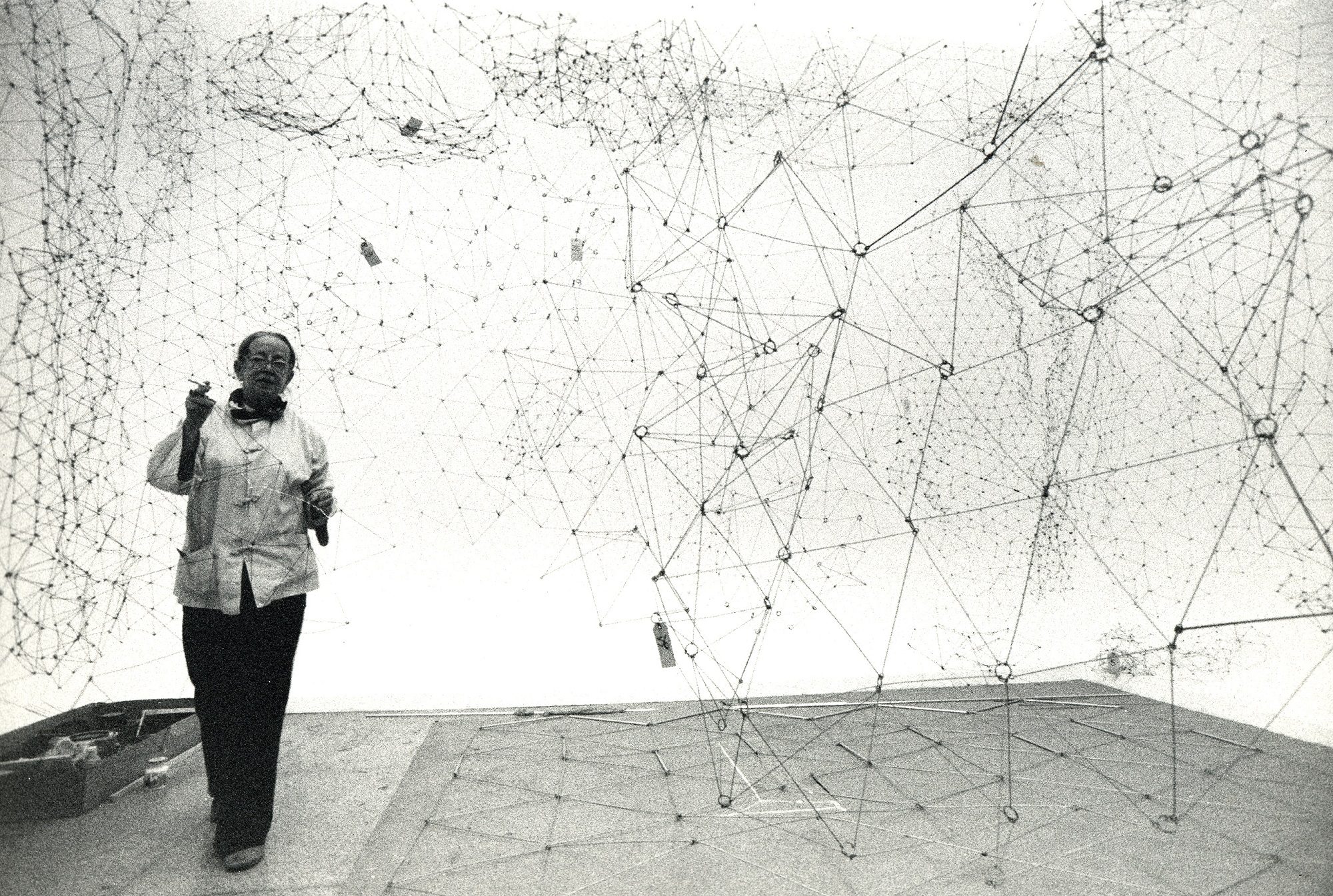
Gego is a German-Venezuelan artist and educator considered among the most relevant figures of twentieth century geometric abstraction. In her work, space, lines, and subject commune in unprecedented ways, creating new possibilities for the constructive language of the time and stretching into the present. Her explorations of the spatial experience and drawing in the void find their greatest concreteness in Reticulárea, one of Gego's most representative works. The piece was initially created in 1969, evolving progressively after several installations. It consists of the spatial development of joints between linear pieces that, when assembled together, form an immersive whole: the design of a system of edges with a flexible node, which is capable of generating a rhizomatic structure of an endlessly expansive nature. Although the piece exists as part of the collection of the Fundación Museos Nacionales / Galería de Arte Nacional in Caracas, Venezuela, Gego's Reticulárea has been out of exhibition for more than 10 years, out of its original container, located in the neoclassical building of the Museo de Bellas Artes in Caracas. Thus, the work is inaccessible at a time when museums around the world celebrate the legacy of the artist. In the face of this, the project seeks to reactivate the Reticulárea through a remote collaborative action, in order to bring us closer to a present defined by displacements, migrations, and deterritorialized relations, starting with the legacy of Gertrud Goldschmidt, an artist whose historical context led her to emigrate and create her work in Venezuela.
“Considering the node as a design object, but also as an exchange space is a way of creating relationships in the context of displacements and diasporas; this allows us to learn from Gego's expansive work, to redimension the Reticulárea as a political communal territory through the link.”
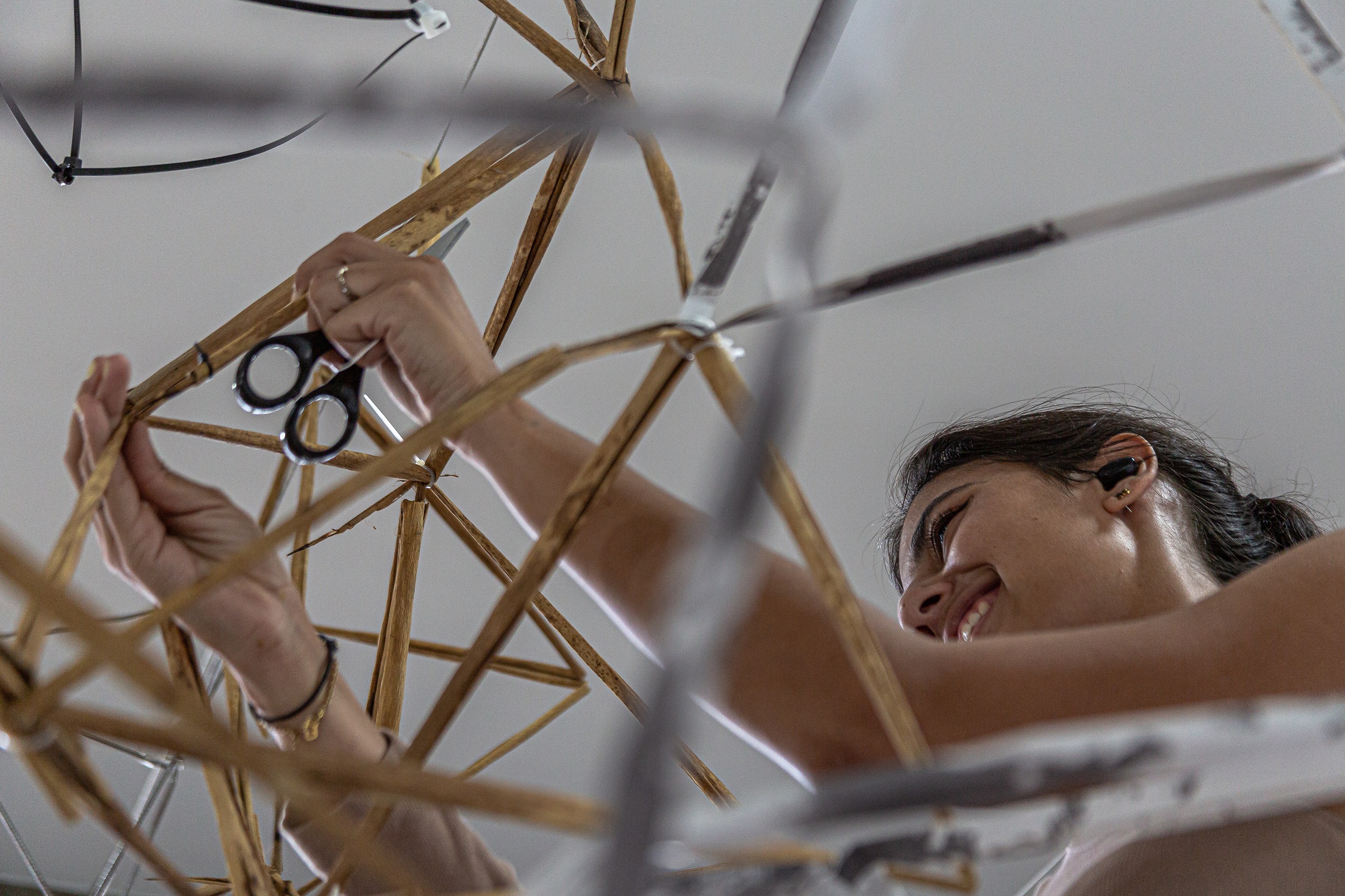



"Redimensioning Gego's Reticulárea from loss and reunion constitutes a powerful symbolic gesture that reorganizes and celebrates what should had never been out of place. It alludes to an affective depth that is updated in the aesthetic framework of the Reticulárea, a matrix of links and ties, which encourages new hands to appropriate its constant rhythm of infinite growth."
The activation of this Collective Reticulárea is proposed from two consecutive instances: as a space for collaborative construction through an open call to add pieces from anywhere in the world, and as an online educational space for teaching artists, using this work as a spatial-geometric learning tool.
Open Call
Aimed at artists and researchers
With the aim of reactivating the concept of the Reticulárea through a remote collaborative action, we invite all people interested in participating in this celebration of Gego's work, to contribute with module-pieces. A network of Venezuelan artists living abroad will offer their studio spaces as collection centers for the pieces-modules, which will later be shipped to Caracas for assembling. Esperanza Mayobre, Lucía Pizzani, Jaime Gili, Elías Crespin, Fabiola Arroyo, María Antonia Rodríguez, Beto Gutiérrez, Valentina Alvarado Matos, Augusto Gerardi, Miguel Braceli, Andrés Michelena, Lenin (Federico) Ovalles, Elisa Bergel Melo, Camilo Barboza and Gabriela Quero are collaborating with their studios to receive pieces in Latin America, Europe and the United States, while the Goethe-Institut Venezuela will receive the contributions in Caracas.The call is open from December 1, 2023 through February 15, 2024, and has the goal of gathering worldwide contributions from people who are interested in celebrating, remembering, and approaching the historical legacy of Gego's work. In this way, the project opens new contemporary connections through collaborative lines and spaces. The call seeks to map contemporary legacies of Gego in Latin America, as well as to create a network of contemporary practices, thus building bonds through lines and collaborative spaces drawn on a visual cartography that allows to hyperlink and access these researches and works in an interactive network. The goal isn't to replicate Gego's Reticulárea but to negotiate and debate new and contemporary spaces of meaning. Gego's interest in finding new forms of space and opening space for new experiences is a guiding model here, as is her practice of collaborative work. Along these lines, the project is proposed as an ephemeral installation, lasting the time of the exhibition at Sala Mendoza, and all the contributions are understood as donations. After the closing of the exhibition, the work will be disassembled and the materials sorted, to be distributed as donations to the public schools participating in the educational project in Caracas. In this way, they will be able to continue exploring pedagogical exercises around spatial practices. Learn more about the ways to participate by accessing the open call here.

Collective Reticulárea: Communal Cartographies. Participatory project by Miguel Braceli. Exhibition at the Sala Mendoza in Caracas, 2024.
Curated by Fundación Gego and Stefanie Reisinger. Photo: Josseline Chalbaud.

Collective Reticulárea: Communal Cartographies. Participatory project by Miguel Braceli. Exhibition at the Sala Mendoza in Caracas, 2024.
Curated by Fundación Gego and Stefanie Reisinger. Photo: Josseline Chalbaud.

Collective Reticulárea: Communal Cartographies. Participatory project by Miguel Braceli. Exhibition at the Sala Mendoza in Caracas, 2024.
Curated by Fundación Gego and Stefanie Reisinger. Photo: Josseline Chalbaud.

Collective Reticulárea: Communal Cartographies. Participatory project by Miguel Braceli. Exhibition at the Sala Mendoza in Caracas, 2024.
Curated by Fundación Gego and Stefanie Reisinger. Photo: Josseline Chalbaud.

Collective Reticulárea: Communal Cartographies. Participatory project by Miguel Braceli. Exhibition at the Sala Mendoza in Caracas, 2024.
Curated by Fundación Gego and Stefanie Reisinger. Photo: Josseline Chalbaud.

Collective Reticulárea: Communal Cartographies. Participatory project by Miguel Braceli. Exhibition at the Sala Mendoza in Caracas, 2024.
Curated by Fundación Gego and Stefanie Reisinger. Photo: Josseline Chalbaud.

Collective Reticulárea: Communal Cartographies. Participatory project by Miguel Braceli. Exhibition at the Sala Mendoza in Caracas, 2024.
Curated by Fundación Gego and Stefanie Reisinger. Photo: Josseline Chalbaud.

Collective Reticulárea: Communal Cartographies. Exhibition at the Sala Mendoza in Caracas, 2024. Miguel Braceli’s educational and performative projects.
Curated by Fundación Gego and Stefanie Reisinger. Photo: Josseline Chalbaud. Courtesy: LA ESCUELA___.

Collective Reticulárea: Communal Cartographies. Exhibition at the Sala Mendoza in Caracas, 2024. Miguel Braceli’s educational and performative projects.
Curated by Fundación Gego and Stefanie Reisinger. Photo: Josseline Chalbaud. Courtesy: LA ESCUELA___.

Collective Reticulárea: Communal Cartographies. Exhibition at the Sala Mendoza in Caracas, 2024. Gego’s educational projects.
Curated by Fundación Gego and Stefanie Reisinger. Photo: Josseline Chalbaud.
Educational Project
Aimed at teaching artists
Through online and on-site sessions designed for reflecting on Gego's work and putting her research and geometric operations into practice, artist Miguel Braceli will invite Latin American teaching artists to develop a series of workshops in their localities. These sessions will be oriented toward an exchange around spatial and pedagogical practices, departing from the process of building the Reticulárea, exchanging learning methodologies through Gego's work; an artist recognized for her teaching work in the field of design and architecture.
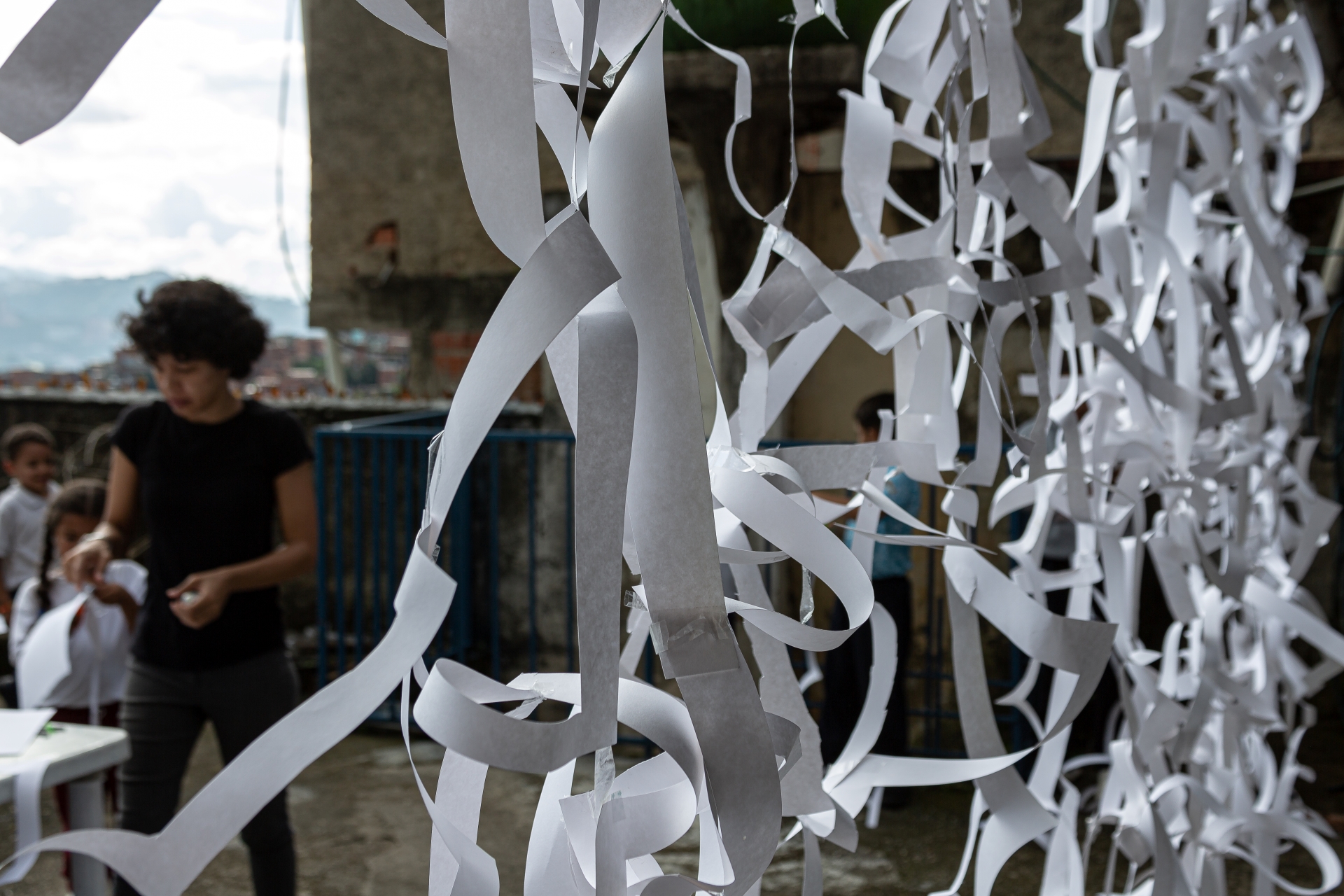





Exhibition
Once the modules have been built and assembled in Caracas, the sum of these pieces will give shape to the Collective Reticulárea. It will be displayed in an exhibition open to the public, focused on broadening the panorama of the artist's pedagogical research and the complex construction processes of her works. The work will be installed by Miguel Braceli in collaboration with students from the Central University of Venezuela, together with professors Diego González and Alba Izaguirre. The exhibition will open on April 13, 2024 at Sala Mendoza, along with an educational program around Gego, her work, and the relevance of her legacy for the history of art in Venezuela and Latin America.
“In Reticulárea Colectiva: Common Cartographies, artist Miguel Braceli proposes the reactivation of the Reticulárea as an opportunity to recover daily experiences of today's Venezuelan society, which are strongly linked to experiences of migration and displacement [...] In this sense, Braceli proposes the project, not only to remember the Reticulárea locked up at the GAN, in Caracas, but also to symbolize the current situation of millions of Venezuelans."
Joining It All Together
by Stefanie Reisinger
As early as 1966, in the context of her participation in the Tamarind Lithography Workshop, Gego wrote about the charm of the "nothingness" between lines, noticing a "sparkling" when they cross or are interrupted. Especially in the unmarked places—the in-between—Gego recognized a productive place, which she then knew how to use in the development of her Reticulárea: In the drawings, which are created parallel to its first installation, she employs this sparkling in a pointed way, by leaving the joints of the depicted endless triangulations and triangular associations "empty" or open. Looking at Gego's work as a whole, this is an important observation—the structural connections within her works are of utmost importance and are evidence of flexibility and adaptability, allowing the artist in her work process to be as "free" as possible. Therewith, she was able to keep her pathways open when creating new forms of working in and with space. For Gego, the desire for such adaptable and ever-expandable solutions may have arisen from a different necessity. Miguel Braceli ties into these demands out of a different need and urgency. His project will, however, employ similar strategies to create a new space through collaborative work by focusing on those open joints and undetermined links between singular elements as productive open fields while reactivating Gego’s Reticulárea in spirit—a work that connects so many Venzuelans around the world through shared memory.



In Collective Reticulárea: Communal Cartographies, artist Miguel Braceli proposes a reactivation of the Reticulárea as an opportunity to revisit everyday experiences of today’s Venezuelan society, which are strongly linked to migration and displacements. This was a significant topic in Gego’s own biography, although it was not explicitly addressed, much less regarding her own work. Nevertheless, there are aspects of form and content that allow her Reticulárea installations to be read in this way, as Monica Amor and Noit Banai, among others, have argued. In this sense, Braceli proposes the project not only to remember the 1969 Reticulárea locked up in Caracas, but also to symbolize the current situation of millions of Venezuelans. Gego was always a visionary, her Reticulárea was built with the hope of new and open forms of space that knew no hermetic borders. She could not have been aware of the sharp actuality of her claim at the time; however, the reinterpretation of her Reticulárea offers a younger generation of Venezuelans the opportunity to update and actualize this claim.
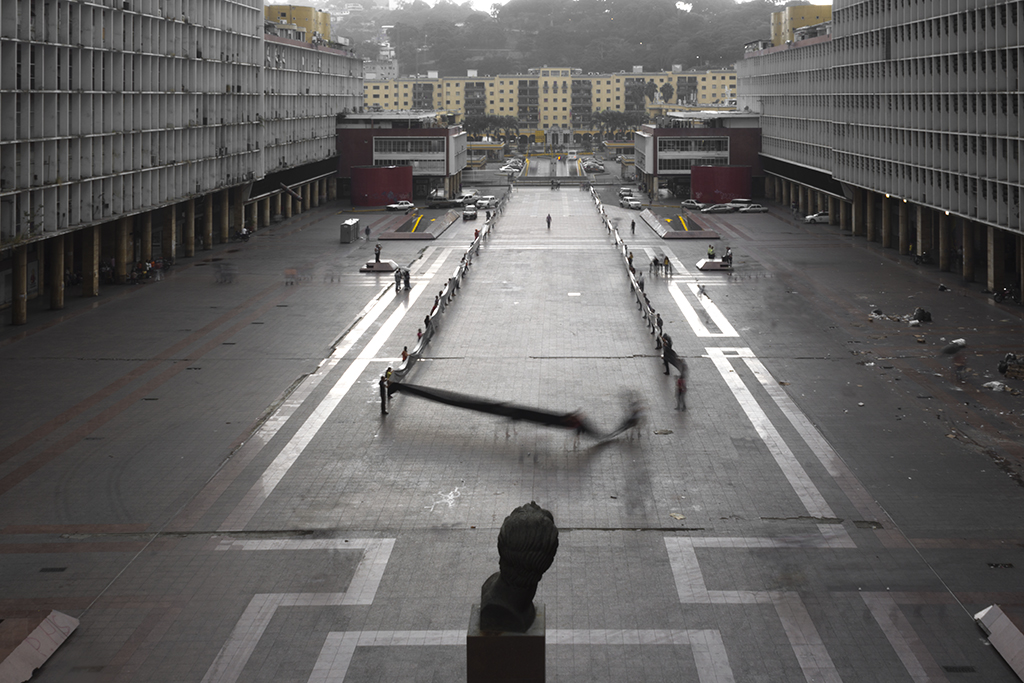






COLLABORATORS
Abigaile Méndez Ramírez, Albert Salazar, Alberto Asprino, Alberto Tejada Herrera, Alejandra Marín, Alicia Coles, Alicia Feaugas, Andrea Victoria Irazabal Puente, Andrés Michelena, Angel Almansor, Ángel D. Leiva, Ángel Marcano, Angelo Padilla, Anghelina Rangel Morales, Anghy Rondón García, Ani Villanueva, Annella Armas, Anthony Jose Villalobos Arreaza, Antonieta Valeska Flores Bastidas, Antonio Torres, Aura Nuñez, Ayar Abel Mendoza Yupanqui, Yhulianov Hortencia Concha Zavaleta, Isabel Paliza Vega, Angela Del Carmen Tenorio Rojas, Becerra Díaz Juan Pablo, Brenda Renison, Carlos Daniel Servin, Carlos Eduardo Rodríguez, Carlos Mendoza, Carlos Qintana, Cipriano Martínez, Christian Novoa, Claudio Valdebenito, Clismary Quintero, Cora Pereira Hors, Cori De Veer Bermúdez, Dania Ilbih, Daniel Briceño Brazón, Daniel Perez Mora, Daniela Catalano, Daniela Vásquez, Delia Edith Pérez Albarrán, Diana Gallardo, Diana Valentina Parra, Edgar Sebastián Márquez Maldonado, Edoardo De Armas Scaccia, Elena Saraceni Anzola, Elio José Benítez Sánchez, Eneko López Toro, Federico Ovalles-Ar, Fiorella Rondón, Franchesca Rubertone, Gabriel Gamero, Gabriela Valentina García Nuñez, George Lavarca Fernández, Gerardo Morantes, Giulia Coletta, Hugo Palmar, Inés Díaz Saubidet, Ingrid Ugueto, Daniel Escobar, Ira León, Ivan Salgrero Curiel, Janelis Chica, Jeiling Angelica Rodríguez Varela, Jessica María Santana, José Luis Delgado, Jesús Moreno-Granados, Jonathan Carvallo Salas, Jorge Eduardo Rosas, Jose Luis Castillo Segovia, Juan David De Freitas Ferreira, Juan David Dugarte Villegas, Juan Pablo Becerra Díaz, Karla Montauti, Leonardo Martinez Hlawacz, Lihie Talmor, Lisandro Castro, Lotta Stöver, Lucina Itzel Pedrozo Lara, Luis Zorrilla, Luisana Velasco, Manuel Herrera, Marbelis Teresa Gutierrez Herrera, Marcela Antipan Olate, María Casto Pastrano, María Celeste Trotta, María Cristina Salgado Gereda, Maria Del Carmen Reyes Garrido, María José García Vela, Maria José Labrador Mora, María Manuela Marquéz Madriz, Mariana Alvarez, Mariana Lugo, Mariana Victoria Rojas Monzalve, Mariangel Gabriella Pacheco Avendaño, Mariangel Marín, Mariangeles Calderin, Mariángeles Soto Díaz, Mariel Fuentes, Michelle Gordillo, Misael Carpio, Muu Blanco Ángulo, Nadia Benatar, Natalia Volpe, Nathalia Velásquez, Nicolás Lapadula, Nilda Perez Peirano, Noremis Cedeño, Oriana Rios, Paola Burigo, Paola Vielma, Patricia Van Dalen, Puentes Entre Cadenas, Rawen Maklad, Reynalíd Carolina Berrio Salcedo, Roberto Ramirez Plessmann, Salomé Rojas, Silvia Soonets, Silvia Soonets, Susan Applewhite, Susana Montilla, Valeria Caribay Vasquez Pacheco, Verónica Florville, Verónica Rodríguez Angulo, Vicente Antonorsi, Victoria Diaz Saravia, Victoria Medina, Victoria Romero Ibañez, Vilena Figueira, Vladimir Vivas Suarez, Wilfredo Gil, Xiomara Sánchez, Yadersy Wetter, Yulietzi Noriega.
